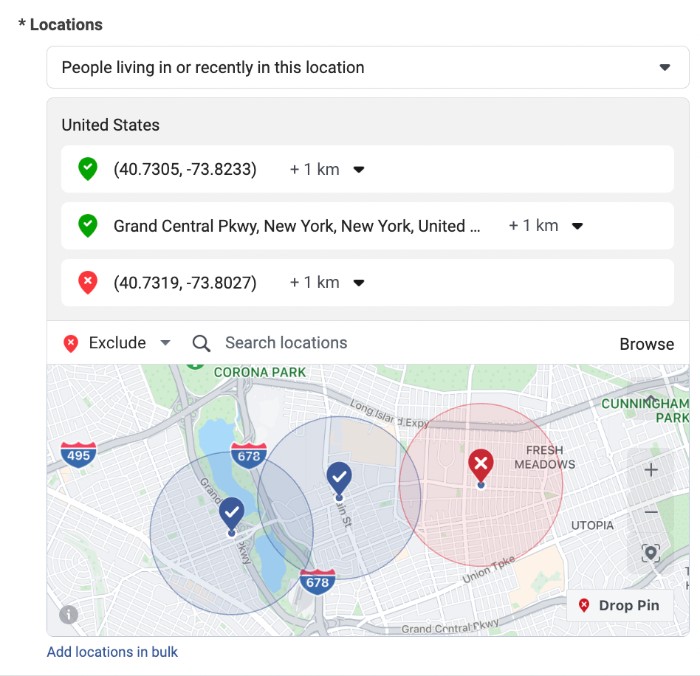Geo-targeted advertising methods allow businesses to reach their target audience by tailoring their ads to specific geographic locations. By using location data, businesses can deliver relevant and personalized advertisements to users in specific regions, cities, or even neighborhoods.
These methods ensure that ads are shown to the right people at the right time, improving the effectiveness of advertising campaigns and increasing engagement and conversions. With geo-targeting, businesses can maximize their advertising budget by focusing on areas where their products or services are in demand, ultimately driving higher ROI and better results.
Whether it’s through IP targeting, geofencing, or location-based mobile advertising, geo-targeted advertising methods offer a powerful way to drive targeted traffic and connect with potential customers in specific geographic areas.
Importance Of Geo-targeted Advertising
Geo-targeted advertising allows businesses to tailor their marketing efforts to specific geographic locations, ensuring that their messages reach the right audience.
By targeting ads based on location, businesses can enhance the relevance of their content, making it more engaging and appealing to their target audience.

Credit: www.adjust.com
Common Geo-targeting Strategies
Discover effective geo-targeting strategies for targeted advertising campaigns. By focusing on location-specific data, businesses maximize audience reach and engagement for better marketing outcomes. Implementing precise geographic targeting leads to boosted ad relevance and increased conversion rates.
Introduction: Geo-targeting is a powerful advertising method that allows businesses to tailor their marketing messages to specific locations and audiences. By using geo-targeting strategies, companies can increase their chances of reaching the right customers at the right time and in the right place. In this article, we will explore some common geo-targeting strategies, including location-based targeting and behavioral targeting.Location-based Targeting:
Location-based targeting focuses on reaching audiences in specific geographic areas. This strategy allows businesses to create campaigns that are relevant to customers within a particular region. With location-based targeting, companies can target customers based on their city, state, or even zip code. This method is particularly useful for local businesses that aim to attract customers in specific locations. One effective approach to location-based targeting is to use geo-fencing. Geo-fencing involves setting up a virtual perimeter around a particular area, such as a city or neighborhood. When a user enters this predefined area, they can be targeted with relevant ads or offers. This technique is commonly used by retailers to drive foot traffic to their stores by delivering timely promotions to potential customers in close proximity.Behavioral Targeting:
Behavioral targeting focuses on reaching audiences based on their online behaviors and interests. Instead of targeting customers based on their geographic location, this strategy targets individuals who exhibit specific behaviors or interests. By analyzing user data, businesses can identify patterns and target customers who are more likely to be interested in their products or services. One popular method of behavioral targeting is retargeting. Retargeting involves showing ads to individuals who have previously visited a website or shown interest in a product. For example, if a user visits an online store but doesn’t make a purchase, they can be targeted with ads for that specific product or similar items across different websites they visit. Another behavioral targeting technique is using affinity audiences. Affinity audiences are groups of users who have demonstrated a strong interest in specific topics or industries. By targeting these audiences, businesses can reach individuals who are more likely to engage with their ads and convert into customers. To summarize, location-based targeting and behavioral targeting are two common geo-targeting strategies that businesses can employ to maximize the effectiveness of their advertising campaigns. By understanding the behaviors and interests of their target audience and tailoring their marketing messages accordingly, companies can increase their chances of success in today’s competitive digital landscape.Tools For Implementing Geo-targeted Advertising
When it comes to reaching the right audience with your advertising messages, geo-targeting is a powerful tool that can provide great results. By tailoring your ads based on a user’s geographic location, you can increase relevance and engagement. In this article, we will explore three effective tools for implementing geo-targeted advertising: geofencing technology, IP address targeting, and location-based keywords.
Geofencing Technology
Geofencing technology is a game-changer when it comes to geo-targeted advertising. Using GPS or RFID, businesses can create virtual boundaries around specific geographical locations. Whenever a user enters or exits these boundaries, they can be targeted with customized ads or offers. This precision allows businesses to target their messaging to users who are physically present in a certain area, making their ads more relevant and timely.
Some common use cases for geofencing technology include:
| 1. Retailers using geofencing to send push notifications to customers when they are near a physical store, offering exclusive discounts or promotions. |
| 2. Event organizers using geofencing to send reminders or updates to attendees when they arrive at the venue. |
| 3. Restaurants using geofencing to target nearby customers with personalized ads, enticing them to try their latest specials. |
Ip Address Targeting
Another effective tool for implementing geo-targeted advertising is IP address targeting. Every device connected to the internet has a unique IP address, which can provide valuable location information. By analyzing a user’s IP address, businesses can determine their approximate geographic location and serve them targeted ads accordingly.
IP address targeting can be valuable for various industries:
- Retailers can use IP address targeting to display ads for specific store locations to users in the same city.
- Travel agencies can show ads for vacation packages specific to a user’s current location.
- Local service providers such as plumbers or electricians can target users in their service area.
Location-based Keywords
In addition to using advanced technology like geofencing and IP address targeting, incorporating location-based keywords in your ad copy is an SEO-friendly way to boost your advertising efforts. Including keywords that reference the user’s location helps search engines understand the relevance of your ads to local users, improving your chances of appearing in relevant search results.
For example, if you are a restaurant in New York City, including location-based keywords like “best pizza in NYC” or “authentic New York cuisine” can help you reach users specifically looking for dining options in the area.
In conclusion, geo-targeted advertising tools like geofencing technology, IP address targeting, and location-based keywords provide businesses with effective ways to reach their local target audience. By utilizing these tools, businesses can increase the relevancy of their ads, boost engagement, and drive conversion rates. Incorporating these strategies in your advertising campaigns can lead to improved results and a higher return on investment.
Challenges And Solutions
Geo-targeted advertising has become an essential strategy for businesses looking to reach their target audience in specific locations. However, it comes with its challenges and requires innovative solutions to make it successful. In this section, we’ll delve into the complexities involved in implementing geo-targeted advertising methods and explore effective solutions to overcome them.
Data Privacy Concerns
The use of geo-targeted advertising raises legitimate concerns about data privacy. Collecting and utilizing location data to personalize ads can potentially infringe on users’ privacy. Moreover, various regulations and laws, such as the GDPR, have tightened the guidelines for data collection and usage. Businesses need to navigate these concerns meticulously to ensure compliance while still effectively targeting their audience.
Adapting To Changing Consumer Behavior
Consumer behavior is constantly evolving, especially in the digital age. Geo-targeted advertising methods must continually adapt to these changes in order to remain relevant and effective. Understanding how people interact with digital platforms, their preferences, and their decision-making process is crucial for optimizing geo-targeted ads. By staying abreast of consumer behavior shifts, businesses can tailor their strategies to resonate with their audience.
Case Studies Of Successful Geo-targeted Campaigns
When it comes to Geo-Targeted Advertising Methods, understanding successful campaigns can provide valuable insights. Let’s delve into Case Studies of Successful Geo-Targeted Campaigns across different industries.
Retail Industry Example
- Target: Local shoppers within a 15-mile radius of store locations
- Strategy: Utilized geo-fencing to send personalized offers based on location
- Results: Increased foot traffic by 20% and boosted sales by 15%
Local Service Provider Example
- Target: Residents in specific neighborhoods with high demand for services
- Strategy: Ran targeted social media ads showcasing local testimonials
- Results: Generated a 30% increase in inquiries and improved conversion rates by 25%

Credit: en.wikipedia.org

Credit: www.kontentino.com
Frequently Asked Questions On Geo-targeted Advertising Methods
What Are The Three Types Of Geo Targeting?
The three types of geo targeting are: 1. Country targeting 2. City targeting 3. Radius targeting
What Is Geolocation Advertising?
Geolocation advertising is a targeted marketing strategy that delivers ads based on the user’s location. It reaches potential customers in specific areas, increasing relevance and effectiveness.
What Is An Example Of A Geo Targeting Keyword?
An example of a geo targeting keyword would be “pizza delivery in New York City. “
What Is Geotagging Advertising?
Geotagging advertising is a strategy that targets specific locations to deliver ads to local audiences. It utilizes geographic data to reach potential customers in a specific area, increasing relevance and engagement. This method allows businesses to tailor their marketing efforts to a particular geographical location, boosting their local impact.
Conclusion
Implementing geo-targeted advertising can significantly improve the effectiveness of your marketing efforts. By utilizing location-based targeting strategies, businesses can reach their desired audience, boost engagement, and drive higher conversion rates. With the power of advanced technology and data analytics, geo-targeted advertising opens up a world of opportunities for businesses to connect with their local and global customer base.
